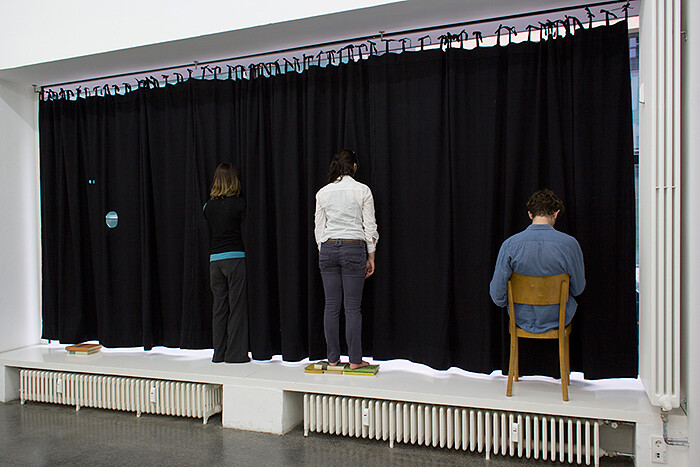Passers-by who found themselves at the farthest reaches of Berlin’s Friedrichstrasse in late April may have been surprised to notice an array of animated body parts on display in a shop window. A pair of eyes, a pair of hands, a face, an arm, two knees and their feet protruded from a black curtain screening off the window. As an introduction to Eva Kotátková’s second solo exhibition at Meyer Riegger, the performative installation, Fragmented Body 1 (installation for a performance) (2013), paid tribute to the long-standing tradition of Prague’s National Black Light Theater Company, and spoke of the potential of gesture and the surprising liberation of physical fragmentation. For those who entered the gallery, however, the pantomime was quickly over, as the performers were revealed from the back in all their ordinariness, standing on the low window ledge with various limbs poking through holes in the black curtain. But in turning the window ledge into a stage, the gallery visitors were at once in the privileged position of being backstage. As a result, the other sculptures on show, such as the Theatre of Speaking Objects (black theatre props) (2013), on a platform which took up the entire floor space of the first room, seemed to be waiting in limbo for actors to animate their schematic forms.
Kotátková’s “Theatre of Speaking Objects” project began at the 2012 Biennale of Sydney and was exhibited in more comprehensive form in an exhibition at the Kunstverein Braunschweig that opened in March. Her approach may be technically more rudimentary than the UV-lit spectacles of the Black Light Theater from which it takes its cue, but it travels into more complex psychological territory in suggesting that the fragment stand in for the whole, or the inanimate object speak for a voiceless individual.
While the performance at the exhibition’s opening during Berlin’s Gallery Weekend was an entertaining diversion, for those who missed it and visited later, when the black curtain with its significantly placed holes was just another unanimated prop, the interest lay more in the artist’s collage works. A dozen small collages of varying formats hung in a close line which wrapped around the far corner of the room. Images of children, adults, or occasionally animals cut out of books or magazines were juxtaposed with urns, masks, or other anthropological-style relics, while webs of finely excised lines in their surfaces inscribed gags, bonds, internal geometries, cage-like architectures, or puppet-like strings onto the figures. These nostalgic-looking, quasi-scientific diagrams demonstrated hidden forces of restraint.
Kotátková’s collages are the most prolific and well-known component of the young Czech artist’s wide-ranging practice, and their depiction of states in which bodies are unable to act of their own free will may be clearly interpreted in light of her early experiences in communist Czechoslovakia. She witnessed firsthand the effects of its dissolution in 1989 (when she was only seven years old) and the subsequent transition to democracy. Since finishing her studies in 2006, she has been a favorite of curators on the biennial circuit, participating in those in Havana, Lyon, Sydney, and Moscow, with a large-scale installation appearing in this summer’s Venice Biennale. No doubt, part of the appeal is Kotátková’s distinctive aesthetic that continues to mark her as a lucid visual analyst of complex social situations. Earlier projects have looked at the legacies of divergent education systems and the treatment of the elderly in the Czech Republic.
Although not as dense as previous installations, full of collages and objects stacked together on shelving components, or multiple room-size stage-like sculptures, in this exhibition, the coherence of the two-dimensional works might have been helped by a sharp edit of some of the more cumbersome, prop-like elements. Not least an enormous white set of stairs (another prop animated only during the show’s vernissage, when actors would take turns rolling down it in slow motion) which partially obscured a particularly poignant work, Not how people move, but what moves them (2013), tucked away behind it. The staged black-and-white photographs in this series showed a man and a woman assuming different postures while their physical inhibitions or learned body reactions were revealed through thread-like lines cut into the pictures’ surface, conveying the inherent difficulties of the body to act freely given the various pressures of ideology, society, architecture, relationships, etc. Rather than practical, automatic, or independent, a body’s gestures are to be interpreted as signs of psychological states, or so these images seem to pointedly suggest.
The aim of Kotátková’s “Theatre of Speaking Objects,” to find a means through which to accord the disenfranchised a voice, transpired literally in the project’s first incarnation in Sydney, in which visitors used various objects or items of furniture as avatars through which to voice concerns they would otherwise be unable to express. Here, however, her intentions are spread throughout the busy exhibition, which, as well as the above-mentioned works, also contains further collage series, prop-like objects, and a half-hour video documenting a Black Light Theater-esque performance. Refusing the increased clarity a more pared-down approach could offer, the artist allows herself a broad scope through which to examine a problem from all possible angles, in all available media. Such proliferation may signal the artist’s considerable energy, but it means that here the problem of inarticulacy speaks in a cacophony of voices.









